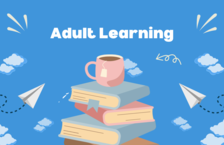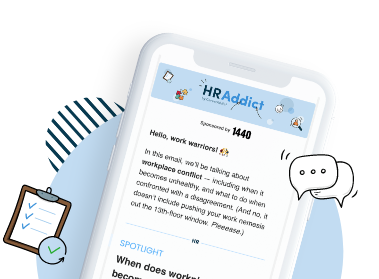This guest post includes sponsored content from Marymount University.
Hands up to anyone who’s sat through painfully slow slide decks and listened to robotic voiceovers.
If you’ve been there, you’ve also probably clicked through compliance modules with the same enthusiasm as watching paint dry. Never mind getting that dreaded email ping, reminding you of your next session. There’s no way out and no way around. Oh yes, and the fact that it’s you doing the presentation.
Your staff feigns interest. Yet, you know the truth. If dry were a place, it would be this cold boardroom-cum-education pod, complete with insufferable PowerPoint slides and forced smiles.
But enough of the dramatic violins before it reaches a crescendo. Employee training doesn’t have to be boring. It shouldn’t be. Your workforce isn’t a classroom full of teenagers. These are adults with lived experience, preferences, and skepticism.
This is where adult learning theory swoops in with a cape (and a whole lot of wisdom).
Understanding how grown-ups truly learn can transform workplace learning from checkbox formalities into messages that stick. Ones that boost their skills, engagement, and retention.
Below, we’ll explore how adult learning theory can take your training strategy from “meh” to meaningful.
TABLE OF CONTENTS
Why should HR care about adult learning theory?
First, a quick reality check: you don’t need a doctorate in education to benefit from its principles (though kudos if you’re working on one).
Adult learning theories, often discussed in Doctorate of Education programs, have practical applications in the HR world.
We’re talking about frameworks developed by educators, psychologists, and organizational theorists who asked: How do adults learn best?
Spoiler alert: it’s not by sitting silently and being lectured to.
Online doctoral programs can open doors, from leadership coaching to consulting careers. That’s why many doctoral students enter the HR field after completing their educational leadership programs.
Student success hinges on core courses and educational practices. Aspiring educational leaders are better equipped with leadership skills and effective leadership strategies.
Know thy learner: The core of adult learning theory
Andragogy
One of the OGs of adult learning theory is Malcolm Knowles. He gave us andragogy, or the method and practice of teaching adult learners.
According to Knowles, adults are:
- Self-directed: They want to take the wheel, not be passengers.
- Experience-rich: They bring prior knowledge and opinions to the table.
- Goal-oriented: They want to know how a particular training program will help them.
- Relevance-seeking: Abstract theory? Meh. Real-world application? Yes, please.
- Motivated by internal drivers: Think job satisfaction, growth, and confidence, not gold stars.
All these imply that your average employee wouldn’t want to feel like they’re back in high school. They want training that speaks to their professional goals, respects their time, and allows them to interact with the content.
Putting theory into practice
1. Give employees autonomy over their learning
Adults don’t want to be micromanaged in their learning journey. Use platforms that highlight the importance of self-paced, flexible training.
Think choose-your-own-adventure, but with professional development. Offer options like:
- Short, snackable videos
- On-demand webinars
- Interactive e-learning paths
- Optional deep dives for overachievers
In other words? Let employees choose when and how they engage. One-size-fits-all won’t cut it—it’s just a fast track to disengagement.
2. Make it relevant, or don’t bother
Nothing turns adult learners off faster than content that feels disconnected from their work.
Tie every module, lesson, or activity to real scenarios they face in their role.
In adult learning, L&D success hinges on focusing less on abstract knowledge and more on developing skills with clear on-the-job application.
No more “just in case” content. Instead, aim for “just in time.” If an employee recently stepped into a management role, teach them targeted leadership micro-courses, not general HR 101.
3. Leverage experience and peer learning
Here’s where you can channel that beautiful thing called cognitive diversity.
Adult learners benefit when you tap into the diverse knowledge that’s already within the teams.
- Create mentorship or reverse mentoring programs.
- Encourage team-led lunch and learning opportunities.
- Let employees contribute to knowledge-sharing platforms.
Everyone becomes both a learner and a teacher. This builds confidence, reinforces learning, and supports collaboration. Win-win-win.
4. Make training interactive
No more “click next” snoozefests. If you’re designing training modules, incorporate:
- Simulations
- Scenario-based learning
- Quizzes with feedback
- Gamified experiences
Why? Because adults learn best by doing, not just listening. Companies can have greater success with learning strategies that embed reflection and active problem-solving.
5. Feedback isn’t a one-way street
Adults want to feel heard. Set aside time for learners to give feedback, not only on their performance but on the training itself.
This method is an inventive way to refine your L&D approach and show employees that their opinions matter. Use simple tools like:
- Post-module surveys
- 5-star rating systems
- Optional comments or suggestions boxes
Training doesn’t have to be static. The best programs are always evolving.
The science-y stuff
Adult learning theory isn’t common sense with a fancy name. There’s some solid science behind it.
Constructivism
This theory says that adults don’t absorb information passively. They build meaning based on what they already know. This learning theory supports the idea of connecting new knowledge to the learners’ past experiences to better retain new information.
Example: Instead of explaining “what good communication looks like,” let staff reflect on past miscommunication and discuss what could’ve been done differently.
Experiential learning cycle (Kolb’s cycle)
David Kolb’s model emphasizes learning through experience, reflection, conceptualization, and experimentation. Hands-on workshops, role-playing, and simulations fall under this construct.
Debrief your team because learning in this method is a cyclical process reinforced by practical applications.
Transformative learning
This one’s about those “aha” moments that change the way we see the world. Create space for critical thinking and reflection, specifically in leadership, DEI, and soft skills training.
Economic uncertainty = opportunity
L&D is sometimes the first to go in a shaky economy. However, that’s a mistake. It’s actually the perfect time to double down on smart, agile training strategies:
- Upskill from within instead of hiring externally
- Retain top talent by investing in their growth
- Create a resilient, future-ready workforce
Guess what underpins those strategies? You got it: adult learning theory.
But wait, there’s more: The EdD advantage
Doctor of Education (EdD) grads don’t hang out in ivory towers. They design L&D programs, lead organizational change, and coach leaders.
EdD grads bridge research and practice, bringing evidence-based learning to the real world.
Whether you’re working with one, are one, or simply stealing their best ideas (respectfully), you’re adding serious value to your HR toolkit.
What you can do today
Let’s wrap this up with some quick wins.
- Audit your current training: How much of it is passive? How much is interactive, experiential, or self-directed?
- Segment your learners: One-size-fits-all doesn’t work. Adjust content to different roles, experience levels, and learning preferences.
- Encourage reflection: Create moments where employees can pause, digest, and test what they’ve learned.
- Champion internal experts: Create opportunities for knowledge-sharing and peer-led development.
- Invest in better content: Yes, it takes time. However, engaging, relevant, adult-focused training is worth every second.
The future of L&D: Smarter, not harder
Training isn’t about throwing more courses into the LMS and hoping for the best. It’s about designing intentional, agile learning ecosystems.
To put blankly - ditch clunky, outdated models in favor of flexible, scalable approaches that put the adult learner first.
Organizations that view learning with a growth mindset are better positioned to keep internal talent, promote innovation, and weather disruption.
This isn’t fluff; it’s a business strategy.
Let’s not forget the human angle. Training that honors adult learning principles doesn’t make people better at their jobs, but can also help them feel more valued, seen, and invested in.
That’s a quiet superpower in the modern job market, where engagement and retention are worth their weight in gold.
As HR professionals, we’re in the ideal position to champion this shift. From revamping your onboarding process to pitching a new leadership academy, adult learning theory is the why and the how.
You don’t need to become a learning scientist. You merely need to think like an educator, act like a strategist, and never underestimate the power of relevance, reflection, and real-world application.
Research how education leadership and cognitive science are interpreted in the postsecondary education sector and build on those ideas. And while you're at it, find creative ways to translate visionary ideas into tangible change.
Working professionals don’t want to be simply trained; they want to be empowered. And that’s what adult learning theory is all about.
It’s probably the greatest feeling when a colleague says thank you because you paved the way for them to “finally get it.” They know what’s expected of them, and when and how to take action. It's a significant contribution you can truly be proud of when your colleagues gain valuable skills with your help.
The best part? Not a single slide presentation was used or harmed during the making of your employee training session.
Time to level up
If your employee training program still feels like school, complete with lectures, tests, and boredom, it’s time for a glow-up.
Adult learners deserve more. When you honor their experience, respect their autonomy, and make learning effective, you unlock the kind of development that drives results.
The next time someone mentions “adult learning theory,” don’t tune out. Lean in. It might be the secret sauce your training strategy’s been missing.

